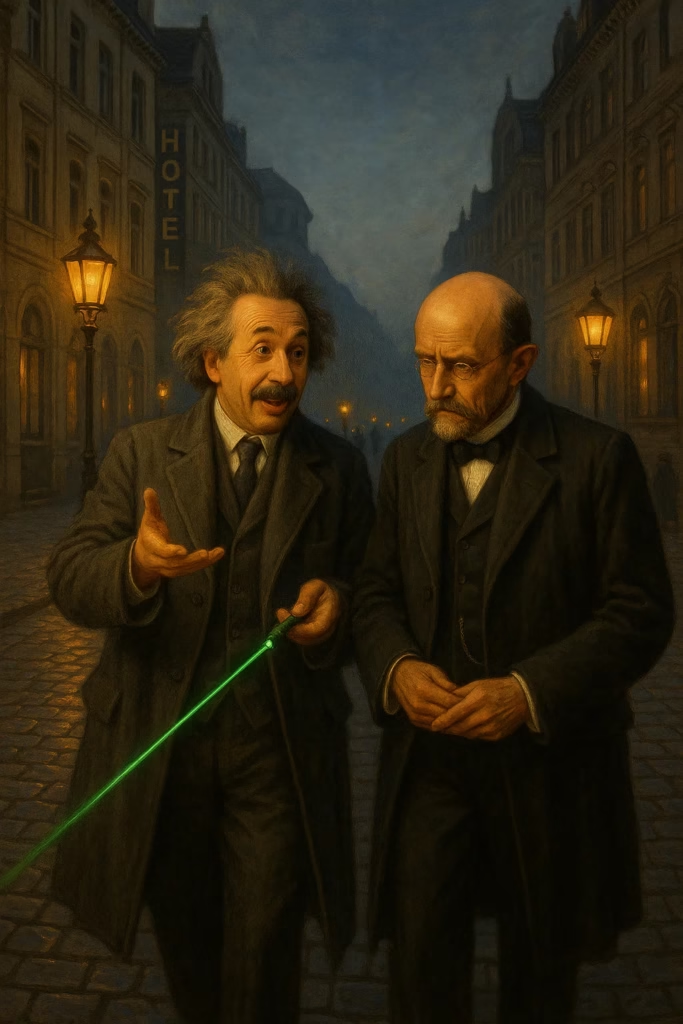When Albert Einstein published his paper “On the Quantum Theory of Radiation” in 1916, the scientific community was still grappling with the uncertainties unleashed by the quantum revolution. While experimentalists like Millikan worked to confirm the photoelectric effect, Einstein was already steps ahead—using pure logical power and mathematical elegance to predict the existence of an entirely new quantum phenomenon that would decades later change the world: stimulated emission.
This was no ordinary theory. It was a triumph of the human spirit, demonstrating how consistent adherence to fundamental physical principles could reveal nature’s deepest secrets.
Starting Point: What Was Known in 1916
Einstein began from three well-established facts:
- Planck’s law of black-body radiation: An empirically and theoretically confirmed description of the energy distribution of radiation in thermodynamic equilibrium.
- Boltzmann statistics: The ratio between the number of atoms at two energy levels in equilibrium is determined by an exponential function depending on temperature and energy difference.
- Elementary processes: Two known ways light and matter interact:
- Absorption: An atom in the ground state absorbs a photon and transitions to an excited state.
- Spontaneous emission: An atom in an excited state spontaneously emits a photon and returns to the ground state.
The Key Problem: A Balance That “Didn’t Add Up”
Einstein applied the fundamental principle of detailed balance: in thermodynamic equilibrium, the number of transitions to a higher energy level must equal the number of transitions to a lower level for every frequency. Otherwise, equilibrium could not exist.
When he set up the equilibrium equation using only these two processes, he obtained a result that sharply differed from the already known Planck’s law. Einstein’s expression resembled the older Wien’s law, which only applied to high frequencies, while Planck’s law had a completely different form, especially in the low-frequency region.
The Limit Case: When Temperature Tends to Infinity
Einstein used the power of limit analysis. When temperature tends to infinity:
- According to Planck’s law, the radiation density tends to infinity
- According to Einstein’s equation, the radiation density tends to a finite value
This was an unacceptable paradox for thermodynamics! A model with only two processes could not describe an infinitely large radiation density at high temperatures. The absorption rate would grow linearly with radiation density, while the emission rate would remain constant. At sufficiently high temperatures, absorption would always exceed emission, permanently disrupting equilibrium. According to this model, the Universe would overheat.
The Genius Leap: Predicting a New Process
Einstein made a brilliant and courageous conclusion: There must be another emission process. This process must, like absorption, depend on external radiation so that the emission rate could match the absorption rate at high energy densities.
He predicted stimulated emission – a process in which a photon of appropriate energy can “stimulate” an atom in an excited state to emit an identical photon.
Reconciling with Reality: Deriving Planck’s Law
When Einstein included stimulated emission in the equilibrium equations, he was able to derive an expression that was identical to Planck’s law. The only way to achieve this was for two fundamental conditions to hold:
- Symmetry between absorption and emission: The probability that a photon will be absorbed must equal the probability that a photon of the same characteristics will cause the emission of another, identical photon.
- Relation between spontaneous and stimulated emission: The ratio of the coefficients of these two processes must match that given by Planck’s law.
Significance: A Masterpiece of Pure Thought
Einstein had no experimental indications of the existence of stimulated emission. He arrived at it exclusively through logical deduction from the principles of thermodynamic equilibrium and the need to align theory with the already existing Planck’s law.
This was one of the “most beautiful moments” in his work. Forty years before Townes, Basov, and Prokhorov invented the maser and laser, Einstein had theoretically predicted the very mechanism that would make them possible.
Without this insight from Einstein, our world without lasers – without modern communications, surgery, barcode scanners, material processing technologies, and countless other applications – would be unrecognizable. This was not just a step forward in physics; it was a step forward in the very way humanity thinks and creates.
In the next post, we will remain in the world of quantum wonders and explore how this, seemingly purely theoretical symmetry, manifested in the real light of lasers and what new paradoxes awaited scientists on that journey.


Leave a Reply